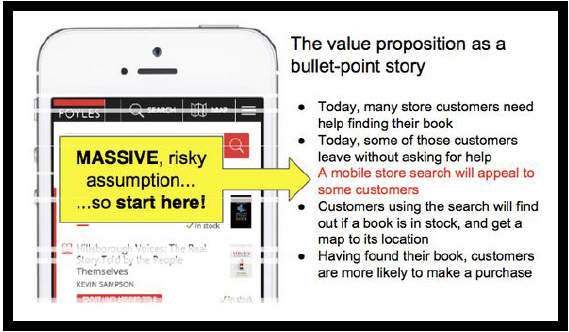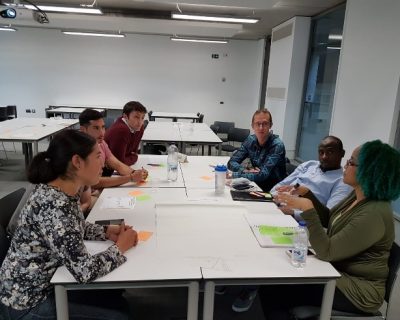Site
Select your branch
Entrepreneurs: How to know whether your idea is a good one.
This lecture at the Säid Business School’s Building a Business series looked at helping entrepreneurs build a successful product. Drawing on Steve Blank’s Customer Development Model, it specifically addressed Customer Validation and Customer Discovery.
The focus was on three key areas:
● Conviction – the entrepreneur’s Achilles’ heel
● How to recognise and test your assumptions
● Validating whether your customer’s problem actually exists
Conviction – the entrepreneur’s Achilles’ heel
It’s a cruel paradox. One of the qualities you need to be a successful entrepreneur is the very thing that can trip you up early on: conviction.
Yes, it’s true that your own conviction helps you take that initial leap of faith. But there’s a very real danger that this same conviction blinds you to the signs that guide a product’s development towards success.
No product’s journey ever follows a perfectly straight line. And no entrepreneur can know their destination from the start. So switching into a ‘search mode’ means putting your convictions to the test before going to market. This searching, and listening to the clues you find, is the first step in refining your product. It provides clues which may well cause you to change direction and ultimately lead to a more robust offering.
You must be ready to truly challenge your conclusions – it is too easy to settle on answers that may simply fit into your preconceived convictions. Searching should lead us to ask:
● Who are my customers?
● Do they really need my product?
● How am I going to reach them?
● Does my product solve their problem?
● Finally, will they buy it?
When it’s done properly the product development process will likely lead you to a totally different end product. So it’s important to avoid one very common mistake – the mistake of just going ahead and building it.
Customer Discovery – How to recognise and test your assumptions
Blank suggests you write a one or two page hypothesis for each part of the Business Model Canvas. Granted, it sounds onerous. In truth, it will save you time and hard-earned cash.
Foyles app – finding the assumption
Foyles recently asked us to help extend the book shopping experience onto their customers’ smart phone. Their value proposition was straightforward: search this store on your mobile.
But first this proposition had to be tested before Foyles spent time and money building an app. And this meant working out their riskiest assumptions.
But how? By putting their Value Proposition down on paper (using the clear bullet-pointed story approach below) we can clearly see the need for the product, as well as the solution and the expected results.
It’s this approach that enabled Foyles to spot their riskiest assumptions easily:
How Foyles validated their assumption
Here’s what Foyles did. For one day they posted signs around their West End stores, promoting the in-store search app. They set up wi-fi to enable customers to try out their great idea on the spot. Except (and here’s the thing) there was no product yet.
So when a customer logged on they were told the app was currently being developed. But as a thank you for showing interest they were given 10% off a book purchase on the day.
Doing this enabled Foyle’s to validate their assumption that it would appeal to customers. But what Foyles didn’t do was spend time and money building a product – which may well have failed – first. (Plus, the customer got a little something for their troubles so it was a win-win.)
Your own assumption testing doesn’t necessarily need to give you such quantifiable data – a strong signal is enough. The key is to make sure the evidence you collect backs up your assumption. Then, your decision to proceed should be based on this evidence you’ve collected. And as we have seen in this example, collating the right evidence quickly and cheaply may mean that you will have to be creative.
Customer validation: does my customer’s problem actually exist?
Your product will be used by people. So it makes sense to get a deeper understanding of your customer. Certainly, understanding your typical customer and the issues they have goes hand in hand with collecting the quantitative data in the Foyles example above. And having both forms of validation allows you to to go back and strengthen your Business Model Canvas.
But it does mean you need to get out there and have real conversations with around 30-50 potential clients.
So what do you speak to potential customers about?
At this stage you are not out to persuade – you are out to collate evidence of their problems (ordesires).
Don’t start by asking a potential customer whether or not your idea is a good one. Chances are that diplomacy will stand in the way of honesty. Plus, we need more than yes or no answers.
Do ask things like “What’s your biggest problem?” – this will allow you to dig for detail by using follow up questions like “Can you give me a recent example?”
You won’t always know exactly what you are looking for either so probing and listening to people’s answers will enable you to discover those unknowns – things you didn’t even think about asking in the first instance. You will always learn something that will fundamentally change your product.
Some things to look out for:
● Talk of workarounds – if potential customers have created their own solution it means they are likely using inferior products to solve their problem. That’s a good sign.
● Enthusiasm – it’s a heartfelt signal that you are developing something that people need.
● Lukewarm responses – Blank says that lukewarm responses can indicate a profound problem. Be brave enough to walk away (or at least change direction).
Once you’ve completed your customer conversations you’ll be ready to adapt your Business Model Canvas. From here, your decision to proceed with a product should be deliberate. Establishing whether a customer problem actually exists will help you make your decision and it is what will enable you to move on to building your Minimal Viable Product – or the simplest version of your product that will get people excited.
In summary
Using Steve Blank’s Customer Development Model you have seen ways to establish whether your idea is a good one. They include:
● Being prepared to challenge your own conviction by collating real, objective
evidence
● Work out and test your assumptions (Customer Discovery)
● Establishing whether your customer’s problem actually exist (Customer Validation)
Some recommended further reading: The Lean Start-up by Eric Ries and The Start-up Owners Manual by Steve Blank.
This article is brought to you by White October, more information about their services can be found here.




